Auto Insurance
78% of Auto Insurance Policyholders Face Rising Rates, but 68% Save by Shopping Around

Auto insurance rates are hitting the gas.
According to the latest ValuePenguin survey of 2,045 U.S. consumers, nearly 4 in 5 (78%) auto insurance policyholders say their premiums have risen in 2023 or they expect them to by the end of the year. And as the new year approaches, most policyholders expect more rate hikes.
Here’s what else we found.
On this page
- Key findings
- Auto insurance premiums are rising — here’s how much more policyholders are paying
- Policyholders who shop around and switch insurance save an average of $398 annually
- 86% of policyholders know about the discounts their auto insurance offers
- Those who haven’t shopped around are happy with their coverage
- Majority of policyholders expect rate increases in 2024
- Shopping around for auto insurance: Top expert tips
- Methodology
Key findings
- It seems everything is getting more expensive, and auto insurance is no exception. A whopping 78% of auto insurance policyholders say their premiums have risen in 2023 or they expect them to by the end of the year. Those whose rates have already increased are paying an additional $270 yearly, on average. With these rising costs, 54% of policyholders say it’s become harder to afford auto insurance.
- With rates on the rise, it pays to shop around. Among auto insurance policyholders, 68% have shopped around to find the best rate, while 57% say they’ve reviewed their auto insurance coverage in the past year. Those who shopped around saved an average of $398 a year on their auto insurance premiums. For most rate shoppers, the process took less than an hour (58%).
- Looking for a discount? Ask and you may receive. 86% of policyholders know about the various discounts that auto insurers offer — and 70% of this group have asked their insurer about them. Meanwhile, 47% of policyholders say they’ve considered increasing their deductible or downgrading their policy to save. Among policyholders, about three-quarters (74%) believe they know everything or most of what their policy covers.
- Those who haven’t shopped around are content with their coverage — or don’t want the hassle. Most policyholders have stayed loyal to their current insurer for more than two years (59%). Among those who haven’t shopped around, 54% say they’re happy with their coverage, 32% think shopping around is a hassle and 25% believe they already have the lowest rate possible.
- Most don’t expect the rate hikes to slow down after this year. About three-quarters (76%) of policyholders expect rate increases in 2024. Of this group, most blame external factors like the economy (74%) or insurer rate hikes (50%). Meanwhile, others openly admit their driving habits (17%) and the driving habits of others in their household (12%) would be behind their rising rates.
Auto insurance premiums are rising — here’s how much more policyholders are paying
If you’ve seen your auto insurance rates rise this year, you’re not alone. In fact, 55% of policyholders report that their premiums have risen in 2023 and 23% expect them to increase by the end of the year.
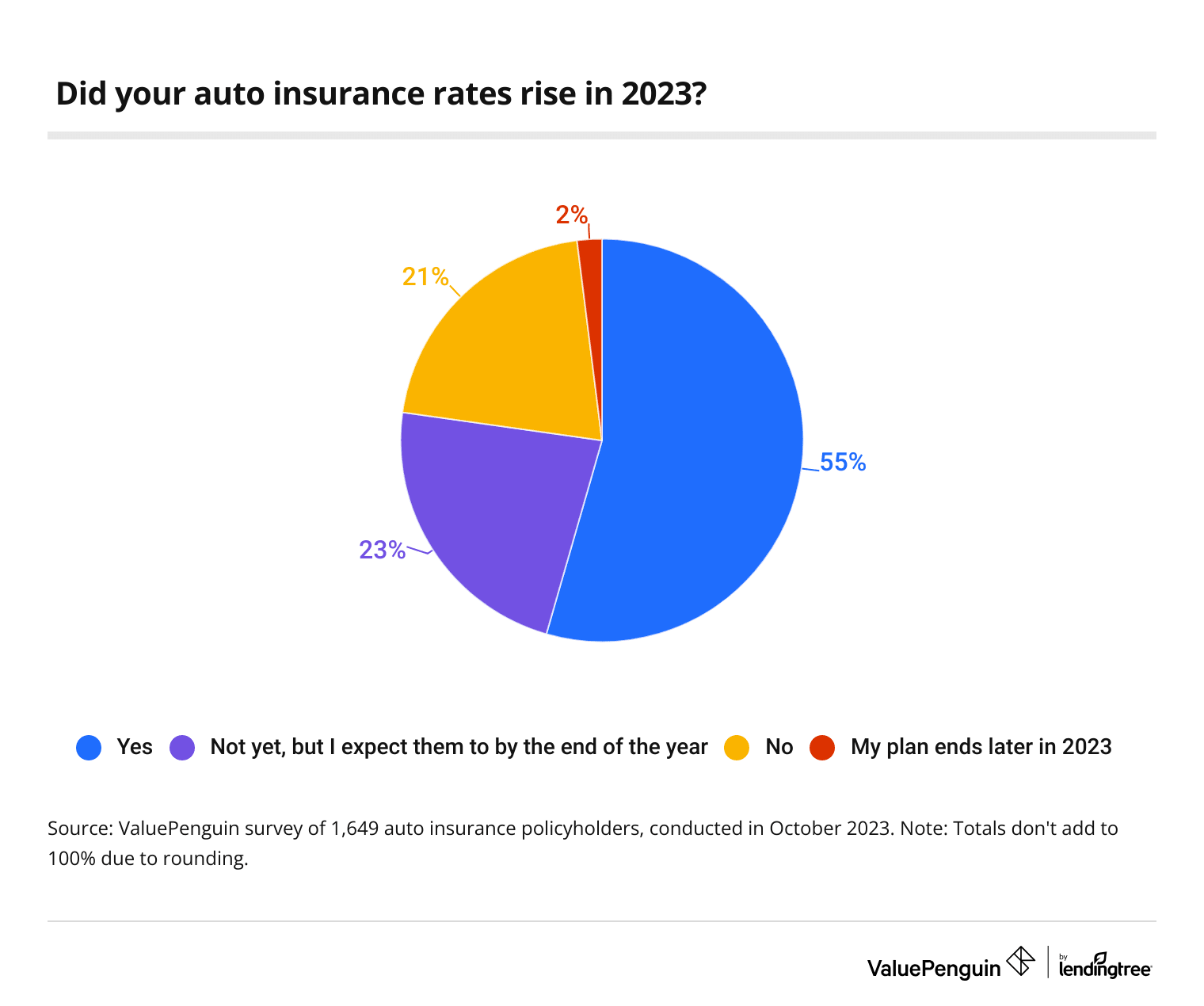
Baby boomers ages 59 to 77 (59%) are the most likely age group to report their premiums went up in 2023. That compares with:
- 57% of Gen Xers ages 43 to 58
- 53% of millennials ages 27 to 42
- 46% of Gen Zers ages 18 to 26
Additionally, policyholders who appear financially healthy are more likely to see their rates rise. Those with FICO credit scores between 800 and 850 (considered exceptional) are the most likely credit score group to report rising premiums, at 64%, while those who don’t know their credit score are the least likely, at 43%. In a similar vein, six-figure earners (65%) are the most likely income group to see rates rise, while those earning less than $35,000 (48%) are the least likely.
How much more are policyholders paying? Among those who’ve seen their rates rise, they’re paying an additional $270 yearly, on average. While baby boomers were the most likely age group to see rates rise, their premiums rose just $172 — the lowest, on average. Comparatively, millennials ($300) saw the largest average rate hikes.
Among women who’ve seen rates rise, their premiums rose nearly 7% more than men who say similarly, at $278 for women and $261 for men.
According to ValuePenguin’s 2023 State of Auto Insurance, insurers increased auto insurance premiums by an average of 8.4%. Additionally, auto insurance represents 3.9% of the typical household's income, according to the ValuePenguin auto insurance statistics and facts page. According to ValuePenguin auto insurance expert Divya Sangameshwar, that can significantly impact policyholders.
"Realistically, due to differences in household income levels, the cost of coverage can take up a larger share of income for many Americans, even if they live in an area where premiums are relatively low," she says. "Auto insurance — like your mortgage, rent, utilities and health insurance — is an inflexible expense. You can’t opt out when money is tight. When auto insurance becomes more expensive, the average American is left with less money for food or other essential expenses."
With these rising costs, 54% of policyholders say it’s become harder to afford auto insurance. That’s particularly true among Gen Zers and women, at 59% for both. Meanwhile, those with exceptional credit scores (42%), baby boomers (45%), men (50%) and six-figure earners (50%) are the least likely to say similarly.
Policyholders who shop around and switch insurance save an average of $398 annually
Given the high percentage of policyholders who struggle to afford their insurance, it may not be surprising that 68% have shopped around to find the best rate before.
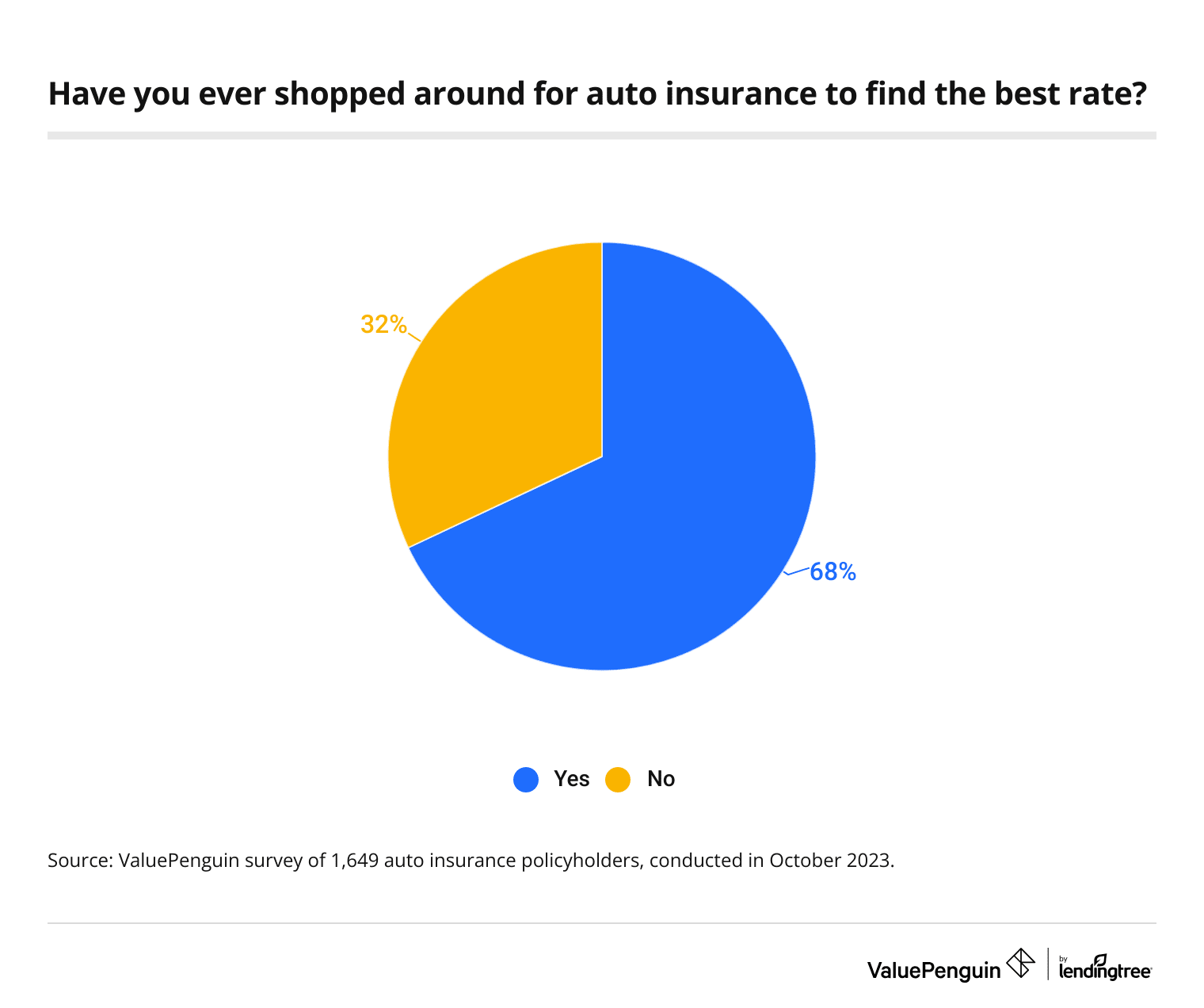
Among the groups most likely to rate shop are those with children younger than 18 (76%) and those with poor FICO credit scores between 300 and 579 (75%). By age group, millennials (71%) are the most likely to shop around, while Gen Zers (64%) are the least likely.
Similarly, 57% say they’ve reviewed their auto insurance coverage in the past year. Notably, women (60%) are more likely to have done so than men (54%). Those with fair credit scores between 580 and 669 (67%), those with poor credit scores (64%) and those earning $35,000 to $49,999 (63%) are the most likely groups to have reviewed their insurance in the past year.
Shopping around certainly pays off: Those who have done so saved an average of $398 a year on their auto insurance premiums. Gen Zers saw the biggest dollar savings by shopping around, saving an average of $659. That compares with an average of $230 saved by baby boomers. Just one other group — six-figure earners — saw similarly high savings, at $607, on average. Also worth noting, men ($429) saved more, on average, than women ($363).
In addition to being cost-effective, rate shopping is relatively fast. For 58% of rate shoppers, shopping around took less than an hour.
86% of policyholders know about the discounts their auto insurance offers
Shopping around isn’t the only way to save on insurance — discounts can help cut costs, too. Across all policyholders, 86% know about the various discounts that auto insurers offer. Those with poor credit scores between 300 and 579 (91%), baby boomers (90%) and those with exceptional credit scores between 800 and 850 (90%) are most likely to know about discounts. Meanwhile, those who don’t know their credit scores (77%) and Gen Zers (77%) are the least likely.
Of those who know about these discounts, 70% have asked their insurer about them. That’s particularly true among the groups most likely to say they know that discounts are available, at 77% among those with exceptional credit scores and baby boomers.
Among those who didn’t ask their insurer about discounts, 37% say they don’t want a tracker or telematics device in their vehicle, 32% don’t think they’d qualify for the discounts and 25% don’t think the discounts would offer them much savings.
For those who didn’t qualify or didn’t save enough, Sangameshwar encourages them to pick up the phone and ask their insurer. "Insurers won’t automatically apply discounts to your policy or inform you of all the discounts you can qualify for," she says. "While bundling discounts are well known, insurers also offer discounts based on driver safety, driver status, the way you pay your premiums, loyalty and the safety features your car comes with. Some insurers also allow you to stack discounts, meaning you can ask to apply more than one discount for more savings."
Of course, she says, the smart thing to do is to get all the discounts you can qualify for and use that discounted rate as a benchmark when you shop around to see if you can lower your rate even further to save more money.
Beyond discounts, 47% of policyholders say they’ve considered increasing their deductible or downgrading their policy to save on insurance costs. Of course, understanding your policy plays a vital role in this cost-reduction method — and not all policyholders feel confident they do. Overall, nearly three-quarters (74%) believe they know everything or most of what their policy covers.
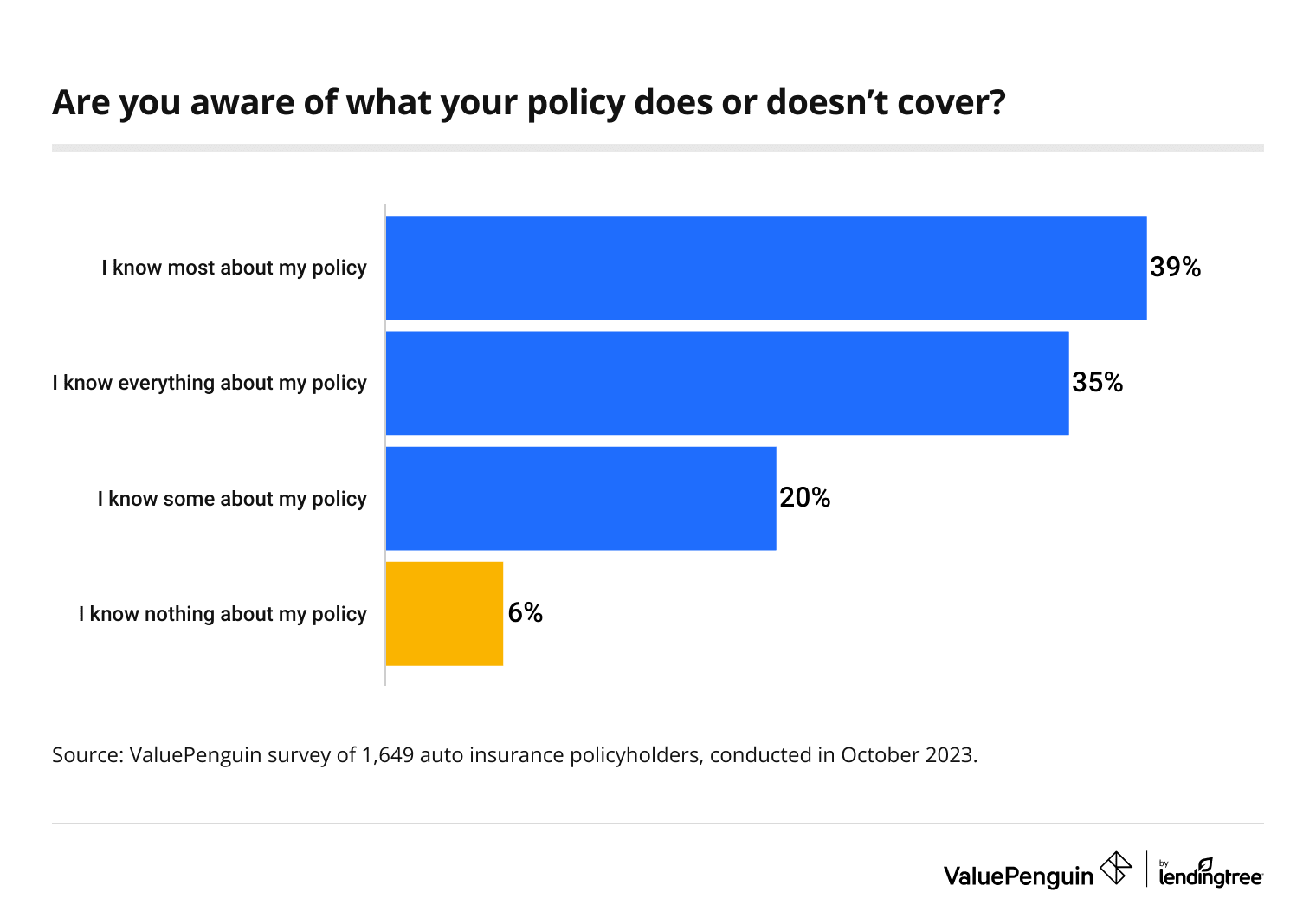
Those with poor credit scores (81%) and those earning $75,000 to $99,999 (80%) are the most likely to say they’re familiar with the contents of their auto insurance policy. Additionally, men (78%) are more likely to say they know most or all of what their policy covers than women (71%).
Meanwhile, just 73% of policyholders know what their deductible is. That percentage is lowest among those who don’t know their credit scores (52%), Gen Zers (53%), those earning less than $35,000 (65%) and those without children (65%).
Those who haven’t shopped around are happy with their coverage
While shopping around offers ample savings, 59% of policyholders have stayed loyal to their current insurer for more than two years and 26% have been with their insurer for one to two years. Baby boomers are the most loyal to their current insurers, with 79% saying they’ve had their policy for more than two years. That compares with just 27% of Gen Zers.
Why don’t more policyholders shop around? Among those who haven’t done so, 54% say they’re happy with their coverage — the most common response. Meanwhile, 32% think shopping around is a hassle and 25% believe they already have the lowest rate possible.
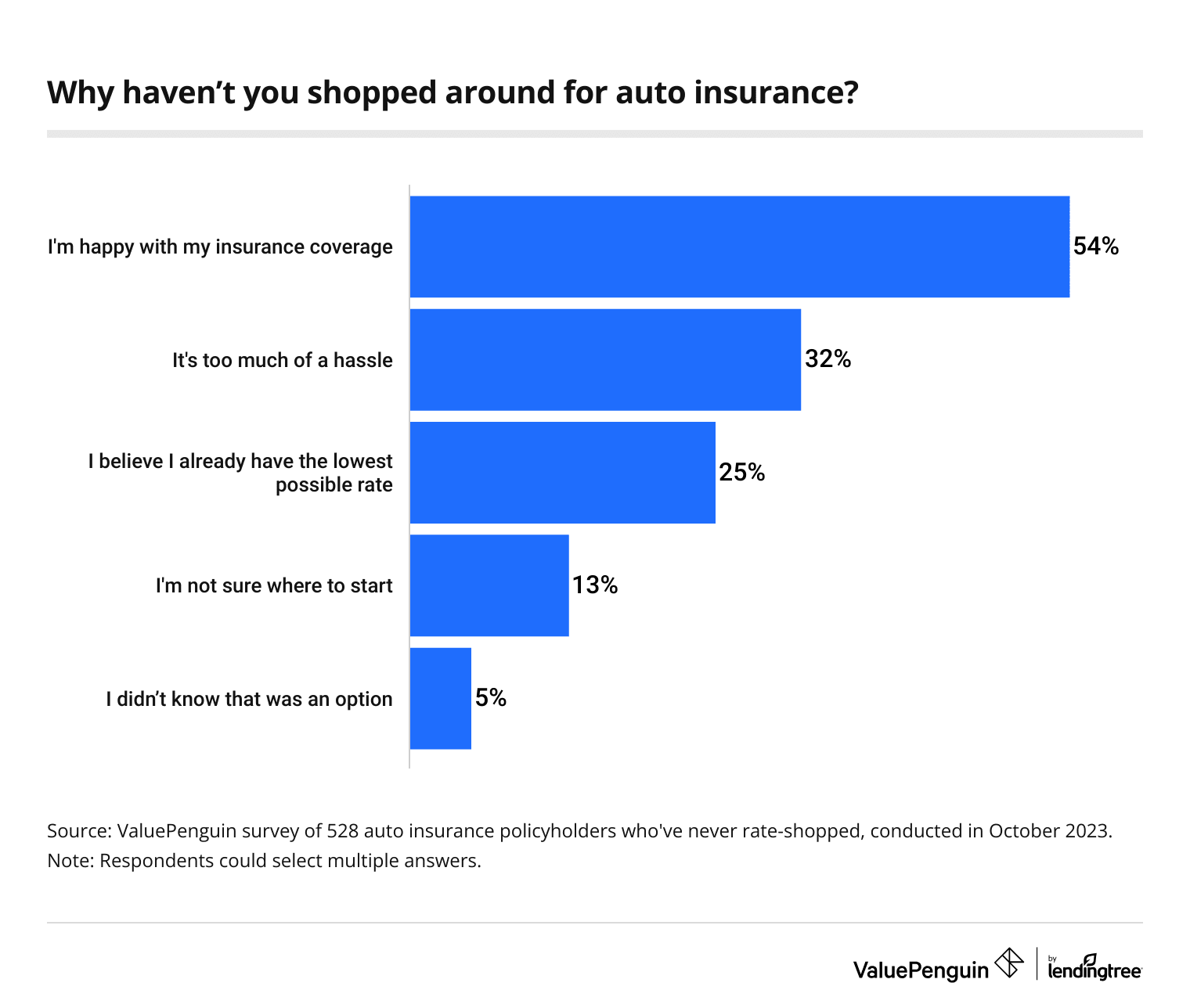
While 13% say they didn’t know where to start, 5% say they didn’t know that switching insurers was an option they could explore.
Notably, men (60%) are much more likely to say they’re happy with their coverage than women (49%). Meanwhile, Gen Zers are particularly likely to say shopping around is a hassle, with 44% citing this reason. For comparison, just 21% of baby boomers say similarly.
Majority of policyholders expect rate increases in 2024
Rate increases have been a pain point for many consumers, but most don’t expect them to end. Across all policyholders, 76% expect rate increases in 2024. Those with very good credit scores between 740 and 799 (83%), those with exceptional credit scores (82%) and six-figure earners (81%) are the most likely groups to expect rate hikes next year.
Based on what they’ve been experiencing this year, Sangameshwar says they’re right to expect more rate increases in 2024. "External factors — like the rising cost of cars and repairs, climate change, a decrease or an increase in crime and accidents — will continue to impact the cost of car insurance in 2024 and beyond," she says. "However, some drivers will also see their premiums increase if they caused an auto accident, had a traffic violation or added a new driver to their policy."
Of policyholders who expect rate increases, 74% say the economy would be to blame — the most common response. That’s followed by insurer rate hikes (50%). Meanwhile, 17% blame their driving habits and 12% blame the driving habits of others in their household.
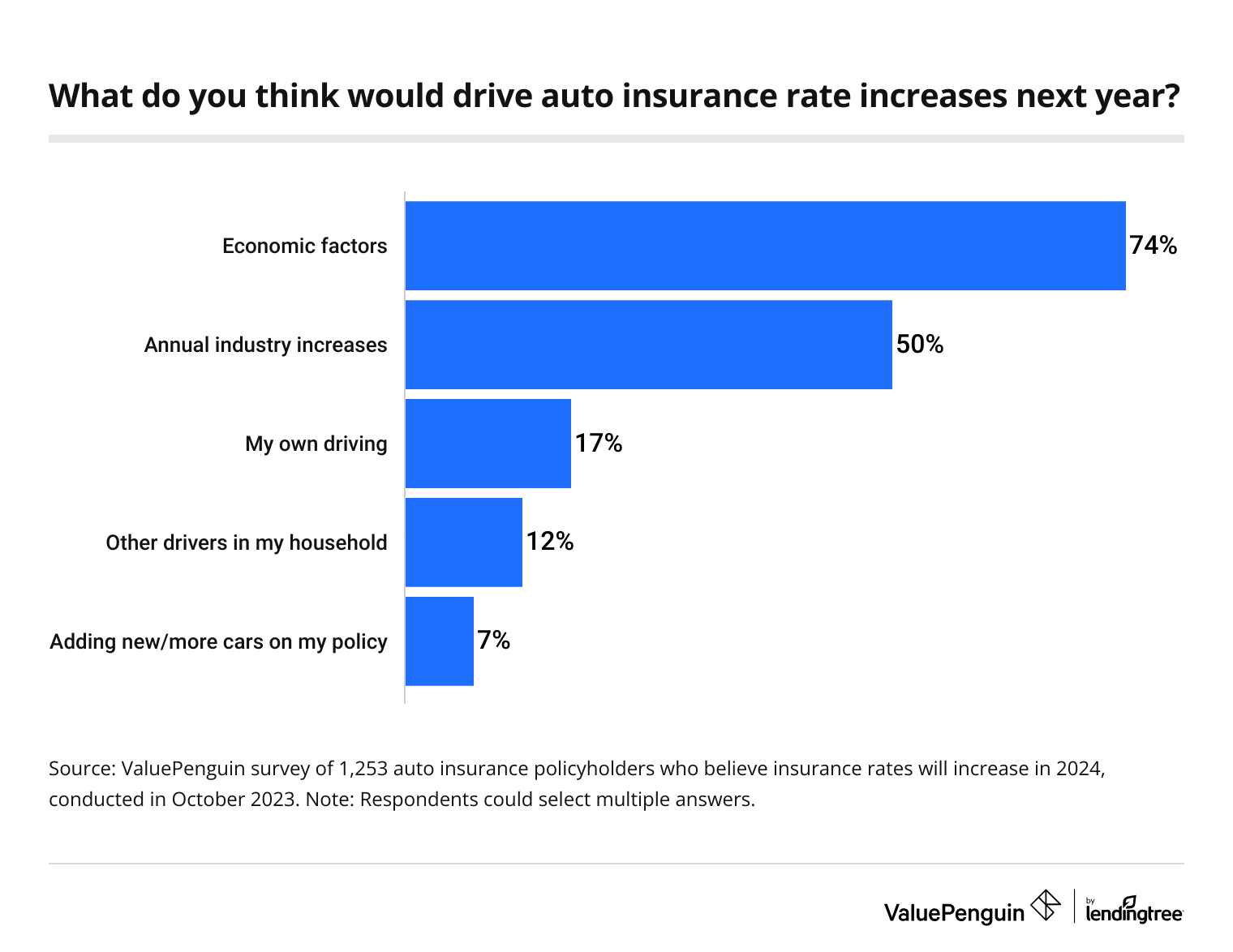
Gen Zers are more likely to admit they or their family would be to blame for rate increases, with 31% blaming their driving and 21% blaming other drivers in their household — higher than any other generation.
Shopping around for auto insurance: Top expert tips
With rates on the rise, Sangameswhar says shopping around can be incredibly valuable. For those starting the process for the first time, she offers the following advice:
- Get all necessary information ready. To get an accurate auto insurance quote, your insurance agent or an online comparison site like ValuePenguin or LendingTree will need information about you, all the other drivers on your policy, your vehicle(s) and the details of your current policy.
- Determine your coverage needs. "To determine if you’re saving money on auto insurance, you need to determine what level of coverage you want first to avoid being underinsured," she says. "You’ll need to study your current policy as a guide to see what level of coverage you have and decide if you want to add to, retain or reduce your coverage."
- Understand the right way to comparison shop. "While it can be tempting to go with the cheapest policy advertised, it’s important to look beyond just the dollar amount and do an apples-to-apples comparison of policies that offer the coverage you want," she says. "If the prices are still too high, you can adjust your coverage needs and ask for quotes for a policy with reduced coverage limits or a higher deductible to save."
Methodology
ValuePenguin commissioned QuestionPro to conduct an online survey of 2,045 U.S. consumers ages 18 to 77 from Oct. 12 to 15, 2023. The survey was administered using a nonprobability-based sample, and quotas were used to ensure the sample base represented the overall population. Researchers reviewed all responses for quality control.
We defined generations as the following ages in 2023:
- Generation Z: 18 to 26
- Millennial: 27 to 42
- Generation X: 43 to 58
- Baby boomer: 59 to 77
